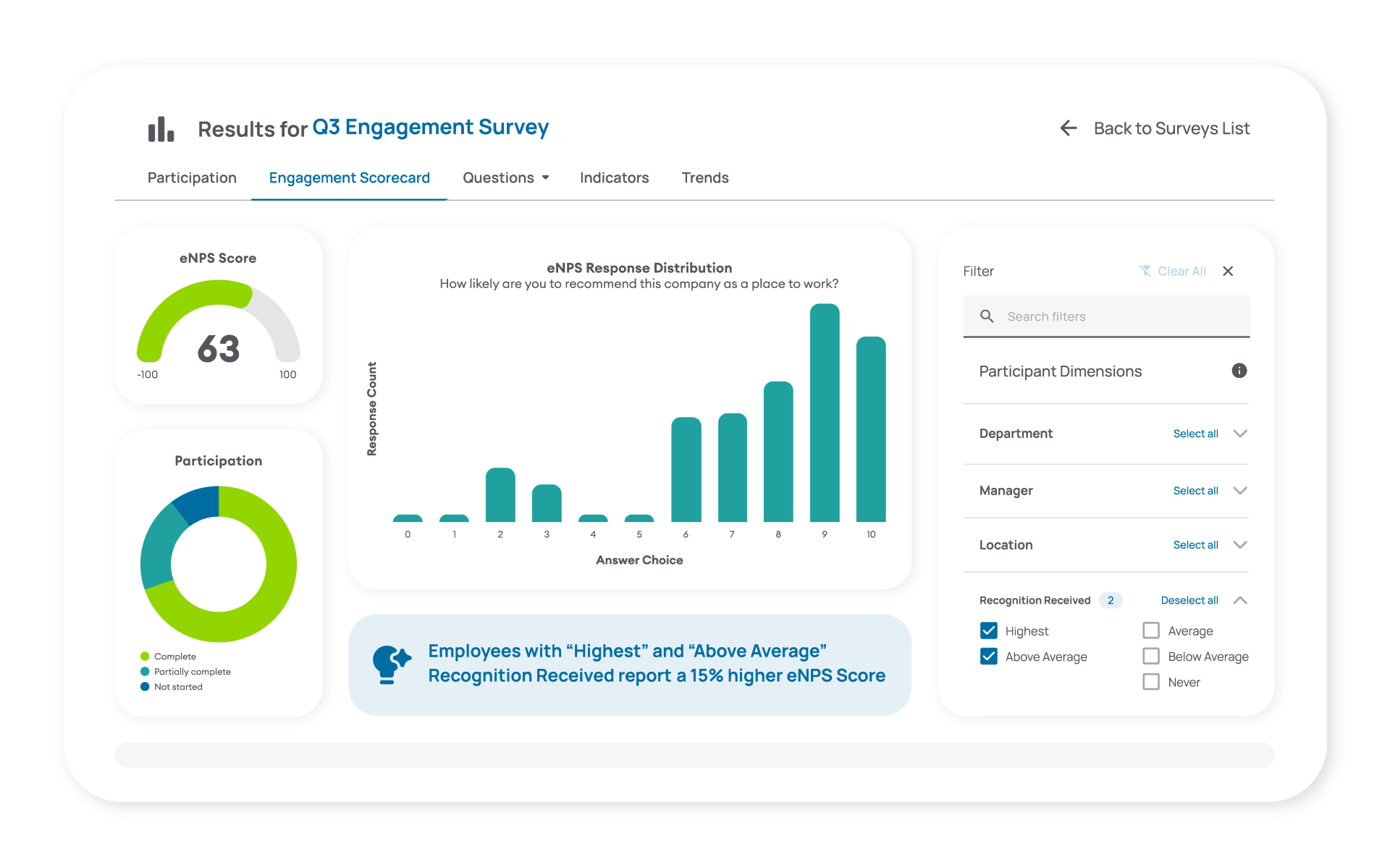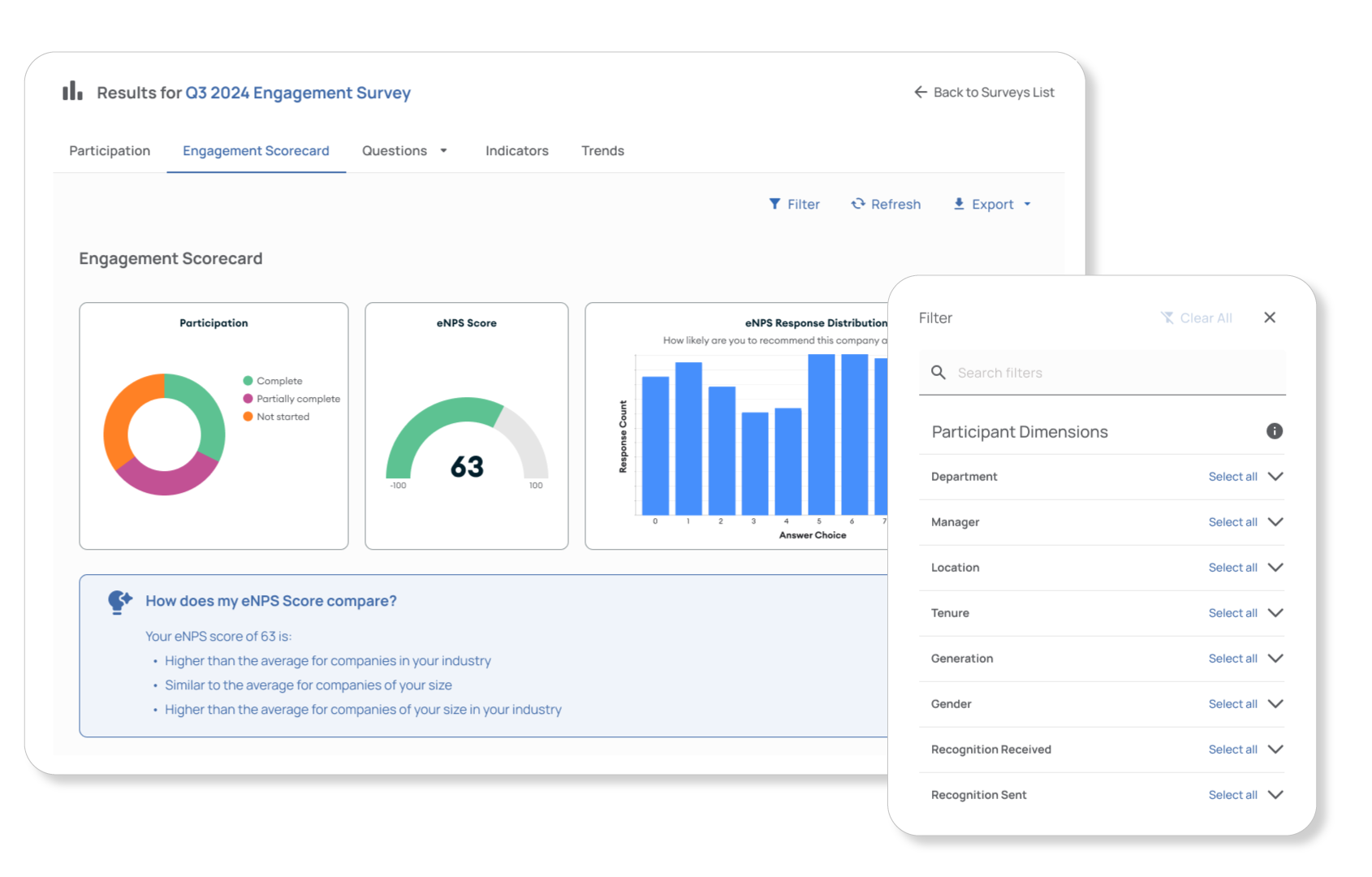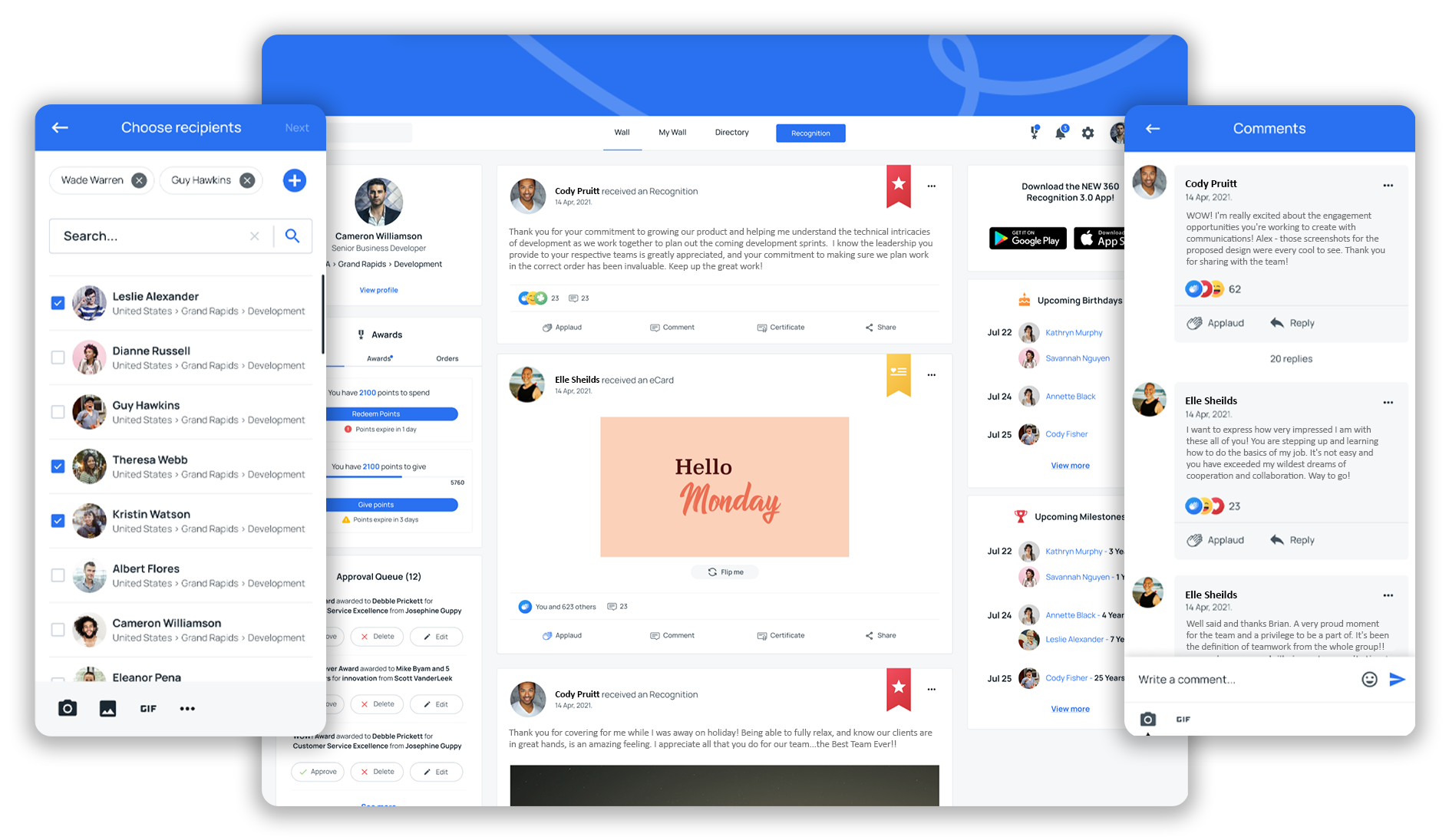June 4, 2025

Your employees are your company’s most valuable asset, but it might not always feel that way.
Without a comprehensive and effective employee listening strategy, you may be taking your workers for granted—and that could be pushing them towards an avoidable early exit.
Employee listening is more than just surveys and data gathering—it’s gathering meaningful insights and inspiring data-driven actions.
It’s shifting away from gut decisions and industry best practices towards personalized approaches and decision-making tailored to your employees and their unique needs.
Done right, employee listening can help:
- Attract top talent
- Retain employees
- Engage your workforce
- Create a best-in-class employee experience
- Identify weaknesses
- Proactively solve problems
- Share success stories to demonstrate the positive impact of employee listening strategies
New to an employee listening strategy? We’ve got you covered.
Below, we'll walk you through everything you need to know to build an employee listening strategy custom-made for your business and employees.
What Is Employee Listening?
Employee listening is a strategic method of hearing your employees’ thoughts, opinions, and concerns.
It’s about transforming communication into a two-way conversation—where employees can comfortably voice their wants and needs in a safe and supportive environment. Maintaining a continuous conversation between employees and management is essential, as it ensures ongoing dialogue and helps capture real-time feedback and concerns.
An employee listening program gives workers stages, situations, and tools to safely share their thoughts, and then it’s up to you to listen and proactively take steps to address their concerns.
Here are a few employee listening tools you can use to encourage employees to speak up:
To encourage employees to speak up and share their thoughts, organizations can use an employee listening tool, such as EmployeeXM™, along with other methods like:
- One-on-one meetings
- Focus groups
- Anonymous suggestion boxes
- Online chats
- Pulse surveys
- Engagement surveys
- Experience surveys
- Performance feedback
- Social feedback
Understanding Employee Experience
A positive employee experience doesn’t happen by accident—it’s shaped by every interaction, process, and policy that employees encounter throughout their journey with your organization. An effective employee listening strategy is the key to understanding what your workforce truly values and where their most pressing concerns lie.
By gathering feedback through employee engagement surveys, pulse surveys, performance reviews, and focus groups, you gain access to key insights that reveal how employees feel about their day-to-day work, their relationships with colleagues and managers, and the overall workplace culture. These insights allow you to see beyond surface-level satisfaction and uncover the real drivers of engagement and productivity.
A successful employee listening strategy empowers you to address issues before they escalate, celebrate what’s working, and make data-driven decisions that enhance the employee experience.
When employees see that their feedback leads to meaningful action, they feel valued and heard—boosting morale, loyalty, and performance. Ultimately, prioritizing employee listening not only improves individual experiences but also strengthens your organization’s ability to attract, engage, and retain top talent.
Does Your Company Need an Employee Listening Program?
Every business could benefit from an employee listening program.
Without direct feedback and conversations with your employees, you’ll just be throwing resources at your workers and hoping something sticks. To drive meaningful change, it's essential to gather employee feedback systematically as part of a strategic and sustainable listening program.
While that might work from time to time, it’s not a sustainable strategy for attracting, retaining, and engaging top talent in the workplace.
You need insights and analytics to make data-backed decisions concerning your employees. Understanding employee perceptions through surveys and feedback is crucial for making meaningful improvements.
Here are a few things to consider:
- What benefits should you include in your package?
- Do employees feel like they’re being fairly compensated?
- Does your workforce feel safe bringing up controversial ideas?
- Can all your employees bring their authentic selves to work?
- Is anyone subject to unconscious bias or discrimination in the workplace?
When addressing these sensitive issues, it is essential to involve key stakeholders from the start to ensure effective solutions and broad support.
86% of employees feel that people at their workplace aren’t heard fairly or equally, and 47% of workers believe the voices of historically marginalized communities aren’t represented. And for those that do feel heard, 40% of them don’t feel their feedback leads to actionable change.
You might feel like your workplace is different, but you’ll never know for sure without a comprehensive employee listening program.
Why Use Employee Listening Tools?
The workplace is changing quickly, and your business can’t afford to wait (or rely on) industry studies and data. You need actionable insights to know how to boost employee engagement, and you need it as fast as possible.
Employee listening and feedback tools help you collect real-time insights from your staff. It is important to actively gather feedback from employees during their interactions with company platforms, using methods like pop-up surveys or site intercepts.
You can poll them as often as you want and create a work culture of transparency and accountability with open communication. Feedback enables organizations to make improvements to the employee experience and better align with organizational goals.
Here are a few examples of things you could learn with employee listening tools:
- Discover if managers are under (or over) performing by measuring manager effectiveness
- Learn how the morale at the business is doing
- Find out which benefits your employees want
- See if diversity, equity, and inclusion (DEI) training is working
- Uncover if there are any issues, discrimination, or unconscious bias
- Learn if employees are engaged with their work
Discovering this information proactively is better than waiting to hear it during an employee’s exit interview.
Your employees’ wants and needs aren’t set in stone. What’s important to them in January might not be important in September, and your business needs real-time insights to make the best decisions.
How to Build an Employee Listening Strategy
A comprehensive employee listening strategy involves more than just sending out sporadic surveys to see how your employees are doing. Aligning your employee listening approach with business priorities ensures that your efforts address the organization's most critical goals and challenges.
Additionally, developing a well-defined survey strategy is essential for gathering meaningful insights and building an effective employee listening approach.
It requires goal-setting, regular check-ins, appropriate listening channels, accountability, and action.
1. Set Clear Goals
It may sound simple, but one of the most important steps in employee listening is clearly defining your goals. So, take the time to outline what you hope to accomplish with your employee listening program.
Do you need to solve cultural issues, or are you looking to boost employee engagement? How will you measure success, and what does success look like? As you set these goals, it's crucial to identify the right feedback to collect so that your efforts align with your objectives and drive meaningful outcomes.
These goals will be what you refer back to over time to gauge how effective your employee listening methods really are.
2. See What's Working
Look at the tactics and strategies you’ve used to gauge your employee engagement survey feedback in the past. Do you find more engagement from focus groups or surveys? Employee focus groups are a valuable qualitative feedback tool within your employee listening strategy, as they facilitate deeper employee discussions and complement surveys by involving employees directly in decision-making processes.
Do your employees feel comfortable speaking up in all-hands meetings, or do they prefer to use anonymous suggestion boxes?
Keep in mind, some of your more introverted employees may have great ideas that they’re too self-conscious about to share. Use this information to drive which methods you should devote most of your resources into developing.
3. Choose Your Listening Channels
Determine which channels you will use to collect employee feedback and insights.
Something like a Google Form might help you manage survey responses well, but an employee engagement survey solution can help you turn your survey data into actionable insights. These solutions also make it easier to send surveys to the right audiences at the right times, ensuring you gather relevant feedback and avoid survey fatigue.
Also feel free to ask your employees what tools they’d like to use to provide feedback.
4. Analyze Your Data
Gathering data is just the beginning—next, you need to convert it into insights you can use. Designing effective survey questions is essential to ensure you gather meaningful feedback that addresses your organization's needs.
For example, if you announce a change to your benefits program, don’t wait until the end of the year to figure out what your employees think about it.
Send out a quick-and-easy survey your employees can complete in less than 60 seconds.
Data cuts and visualization charts can help you make sense of your raw data. Interpreting survey results is crucial for gaining actionable insights into employee perceptions and organizational issues.
Leveraging targeted insights from your survey data allows you to identify specific areas for improvement and tailor your strategies accordingly. Sometimes, it just takes an illustration to give your team the “aha” moment it needs to make the right decision.
5. Act on Feedback
Use these data points to drive action. When making decisions that impact your employees, link them back to your employee listening data.
Prioritize areas that require attention and create actionable steps to address them. It’s important to act quickly on employee feedback to maintain engagement and show that their input leads to real change. Turning feedback into concrete actions helps drive organizational improvement and demonstrates the value of continuous listening.
Communicate the action plan to your employees to let them know their feedback is being taken seriously and their voices are heard.
6. Build a Safe and Inclusive Environment
Foster a culture of psychological safety where employees feel comfortable expressing their opinions and concerns without fear of negative consequences.
If employees are too afraid to speak up, your employee listening feedback will be superficial, which won’t help drive change or engagement.
Encourage open and honest communication by ensuring that all employees have equal opportunities to share their feedback, regardless of their position or level in the organization. Inclusive employee listening efforts help ensure that all voices, including those of full-time employees and contingent workers, are heard and valued.
Implementing Continuous Employee Listening
Gone are the days when an annual engagement survey was enough to understand your workforce. Today’s employees expect their voices to be heard regularly, not just once a year. That’s where a continuous employee listening strategy comes in.
By moving beyond annual surveys and embracing ongoing feedback opportunities, you create a culture where employees know their opinions matter all year round. Regular pulse surveys, open feedback sessions, and always-on communication channels allow you to gather real-time insights and respond quickly to emerging challenges or opportunities.
This approach not only helps you track progress and spot trends but also ensures that you’re always in tune with the evolving needs of your team.
A continuous listening strategy also helps prevent survey fatigue by keeping feedback requests short, focused, and relevant. Employees are more likely to participate when they see that their input leads to timely improvements.
Leveraging modern employee listening tools streamlines the feedback process, making it easy to collect, analyze, and act on survey data. The result is a more agile organization—one that can adapt quickly, foster trust, and deliver a consistently positive employee experience.
Measuring Employee Listening Effectiveness
Building an employee listening strategy is just the first step—measuring its effectiveness is what ensures your efforts are truly making a difference. To assess whether your listening strategy is driving positive change, it’s important to track a mix of quantitative and qualitative metrics.
Start by monitoring employee engagement scores, survey response rates, and the number of actions taken as a direct result of employee feedback. Metrics like employee net promoter score (eNPS), retention rates, and turnover rates can also provide valuable insights into the impact of your listening strategy on the overall employee experience.
Beyond the numbers, use focus groups, interviews, and pulse surveys to gain a deeper understanding of how employees perceive your listening efforts. Regularly analyze survey data to identify trends, track progress over time, and benchmark your results against industry standards. Most importantly, communicate the changes you make based on feedback—this transparency reinforces trust and encourages ongoing participation.
By consistently measuring and refining your employee listening strategy, you ensure that your approach remains effective, responsive, and aligned with both employee needs and business goals. This commitment to continuous improvement is what transforms listening efforts into lasting, positive change for your organization.
3 Must-Have Employee Listening Tools
With so many employee feedback tools on the market, finding the right one can feel like looking for a needle in a haystack. Many have look-a-like features and functionality, while some charge enterprise prices for a slightly upgraded experience.
These tools are essential components of effective listening programs, which are comprehensive initiatives designed to gather employee feedback, analyze insights, and drive organizational change.
Below, we’ll walk you through three of the core criteria you should use to evaluate employee feedback tools.
1. Employee Engagement Surveys
Use quick, real-time pulse surveys to collect candid feedback quickly. Employee surveys let you easily collect feedback from your employees at regular intervals (weekly, monthly, quarterly, or annually). Annual engagement surveys are especially valuable for gathering comprehensive feedback on overall satisfaction, culture, and engagement.
While one-time surveys can reveal powerful insights, it’s even better when you compare surveys over time to discover trends. Use surveys at different stages of the employee lifecycle to track trends and measure progress over time. Gathering feedback at key moments, such as onboarding, anniversaries, or exits, provides deeper insights to improve employee experience and retention.
Then, if you notice a metric dipping (or moving in the right direction), look for recent factors that might have impacted it.
One-time pulse surveys can be another excellent tool for collecting real-time feedback from employees. Need to make an important decision but can’t wait until the next scheduled survey? You can also use one-time surveys to improve the onboarding process by collecting feedback from new hires at this critical stage.
Find an employee engagement survey platform that comes with all the pre-built tools you need. These should include templates, customizable surveys, sending capabilities, analytics, and automation.
2. Social Feedback and Communication Platform
Empower your employees to support each other and leave public feedback about employee and team wins. 360 feedback tools let your employees provide feedback in a private (or anonymous) way, but a social feedback (or peer recognition) tool makes this process public.
Provide a safe place for this kind of open communication with a social feedback and communication platform—it’s a private space for your employees to chat and comment at work.
A social recognition platform lets your management team step out of the picture for a bit while employees naturally provide thoughts and praise about each other.
3. Anonymous Feedback Box
Sometimes, you don’t need a thought-out survey—you just need a way to let employees anonymously provide feedback and ask questions. Some employees might want to vent, and others may want to ask sensitive questions that they don’t want to be tied to their names.
Let your employees provide feedback on their own schedule with an anonymous feedback box. Some business leaders may worry that anonymous feedback opens up the floodgates to trolling and negative comments, but that’s not always the case.
Employees could be embarrassed about a question they have—whether that’s because it exposes too much personal information (like regarding mental health or a disability) or makes them seem unintelligent or weak.
Employees can use this form to leave thoughts and suggestions outside the scope of regularly scheduled surveys.
You can interact with these anonymous notes to have a back-and-forth conversation where employees feel safe from negative consequences or retaliation.
Listen to Your Employees with Terryberry
Ready to build your employee listening program? Let us help.
Terryberry now offers a complete suite of employee listening tools to supplement your strategy. Our solutions help organizations gather employee feedback efficiently, turning insights into actionable improvements for your workplace. Whether you need pulse surveys, engagement surveys, or a social recognition platform, we’ve got you covered.
These solutions include:
- Service Awards and Performance Awards: Recognize and reward employees based on years of service awards, anniversaries, or performance.
- Social Recognition: Empower your employees and managers to recognize their peers and celebrate successes with an easy-to-use social recognition application.
- Feedback and Communication: Unlock improved feedback and communications with employee and customer feedback solutions.
- Wellness Programs: We make it easy to run wellness programs and activity challenges that increase engagement, expand corporate health, and build team camaraderie.
Ready to learn more? Schedule a demo with our team to get a hands-on walkthrough of how Terryberry can transform the culture of your workplace.




